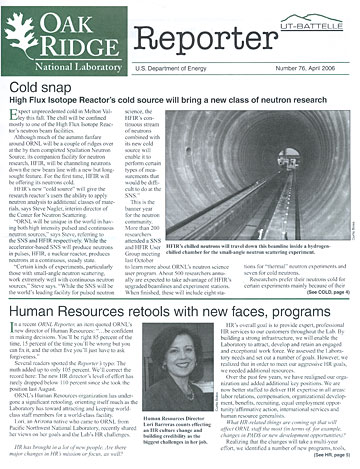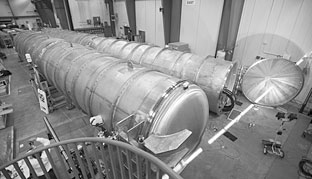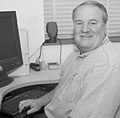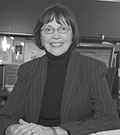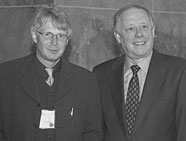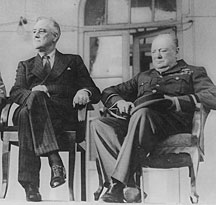 |
Number 76, April 2006 |
 Cold snap
Cold snap
High Flux Isotope Reactor’s cold source will bring a new class of neutron research
|
|
| HFIR’s chilled neutrons will travel down this beamline inside a hydrogen-chilled chamber for the small-angle neutron scattering experiment. |
Expect unprecedented cold in Melton Valley this fall. The chill will be confined mostly to one of the High Flux Isotope Reactor’s neutron beam facilities.
Although much of the autumn fanfare around ORNL will be a couple of ridges over at the by then completed Spallation Neutron Source, its companion facility for neutron research, HFIR, will be channeling neutrons down the new beam line with a new but long-sought feature. For the first time, HFIR will be offering its neutrons cold.
HFIR’s new “cold source” will give the research reactor’s users the ability to apply neutron analysis to additional classes of materials, says Steve Nagler, interim director of the Center for Neutron Scattering.
“ORNL will be unique in the world in having both high intensity pulsed and continuous neutron sources,” says Steve, referring to the SNS and HFIR respectively. While the accelerator-based SNS will produce neutrons in pulses, HFIR, a nuclear reactor, produces neutrons at a continuous, steady state.
“Certain kinds of experiments, particularly those with small-angle neutron scattering, work extremely well with continuous neutron sources,” Steve says. “While the SNS will be the world’s leading facility for pulsed neutron science, the HFIR’s continuous stream of neutrons combined with its new cold source will enable it to perform certain types of measurements that would be difficult to do at the SNS.”
This is the banner year for the neutron community. More than 200 researchers attended a SNS and HFIR User Group meeting last October to learn more about ORNL’s neutron science user program. About 500 researchers annually are expected to take advantage of HFIR’s upgraded beamlines and experiment stations. When finished, these will include eight stations for “thermal” neutron experiments and seven for cold neutrons.
Researchers prefer their neutrons cold for certain experiments mainly because of their longer wavelength. The SNS will also have a cold neutron source.
“Neutrons are quantum particles in that they have a wavelength. That wavelength is shorter when their energy is higher,” Steve says.
Those high-energy, short wavelength neutrons are referred to as “thermal” neutrons.
|
|
| Nagler |
“Thermal neutrons are well suited to harder, more dense materials, but with softer materials you want cooler neutrons with longer wavelengths. This is because these softer materials have larger molecules and structures that can be analyzed more effectively with cooler, longer wavelength neutrons,” Steve says.
Neutrons from reactors are produced by fission. Researchers get access to them by what amounts to tapping into the side of the reactor.
“Think of the neutron source in nuclear reactor as a giant light bulb filled with neutrons. If the black cover surrounding the bulb has a hole, the neutrons stream out. They can be sent down a tube or a beamline to the instruments,” Steve says.
“If the bulb is at a low temperature, it will glow reddish, emitting neutrons with a longer wavelength. A hotter bulb glows white, and the higher the temperature the shorter is the typical neutron wavelength,” he explains.
The neutron scattering pioneers, who included Ernest Wollan and Clifford Shull at ORNL, realized that a major advantage with neutrons, along with their lack of an electrical charge, was that they detected not just the heavier atoms, as light sources do with X-rays, but also the lighter atoms, even hydrogen. That made neutron scattering popular for analyzing light-atom materials.
|
A cold neutron’s wavelength is a better match for materials with larger molecules. |
With their new cold sources, the SNS and HFIR will also be suited to materials with larger-sized molecules and structures.
“With thermal neutrons, the wavelengths are about one-tenth of a nanometer. With softer materials, which include biological and polymer materials, for example, the structures you want to study are more like several nanometers in size, so you want a better-matched wavelength that is closer to one nanometer, which is the wavelength of a typical cold neutron.”
The HFIR ideally runs at its designated power of 85 megawatts to produce an optimum number of neutrons (this is what “high flux” refers to). Its raw-material neutrons are the higher energy room temperature thermal neutrons. To obtain “cold” neutrons, the thermal neutrons are literally cooled down with a super-cold fluid.
HFIR’s neutrons will be chilled to a frosty 20 Kelvin with hydrogen pumped into a beam tube from a refrigeration unit outside the building. Initial testing of the cold source will be with cold helium gas, which is a more inert material but less well suited to chilling neutrons.
|
|
| HFIR’s Cold Source Experimental Hall is dominated by the two huge tanks for the Small-Angle Neutron Scattering Experiment. |
HFIR’s cold neutron beam facility is housed in a structure adjacent to HFIR’s original quarters, representing a significant addition to the facility. The hangar-size high-bay area, with its beam lines that are designated CG-1 through CG-4, will feature two culvert-sized, cadmium-lined cylinders, about nine feet in diameter and 70 feet long, that will contain detectors for the Small-Angle Neutron Scattering, or SANS, instruments. Several other instruments are planned for the Cold Source Experimental Hall, including, among others, a U.S.-Japan Cold Triple Axis spectrometer, a reflectometer, and the inelastic neutron scattering spectrometer called STAR.
The neutron science community is eager to have these new facilities.
“Everything we have is totally dependent on materials. Think of it through the ages—the Stone Age, the Iron Age, the Bronze Age—we’ve depended on materials to advance,” Steve says.
“Back in the ’60s everyone was laughing at Maxwell Smart’s shoe phone. It was preposterous to think that a telephone could be packed in a shoe,” he says as he twirls a tiny cell phone between his thumb and forefinger.
“Cell phones are only possible because we have the materials to make them with, but first we had to understand how those materials behave. For example, decades ago we were using vacuum tubes to rectify electronic signals. Then someone realized, by studying the properties and behavior of electrons in silicon, that transistors could be built that did the same thing in a much smaller space and much more efficiently,” he says.
Researchers will increasingly taking advantage of new tools, such as computer modeling and ORNL’s new neutron sources, to delve into the mysteries of advanced materials in hopes of making them perform some useful function for us.
“Some materials have magnetic properties with very strange quantum effects. Cold neutrons are a real asset for studying those,” Steve says.
HFIR’s upgrade project, which has been in progress over the past several years, has also included, in addition to the installation of the cold source, a new beryllium reflector for the reactor vessel and enlarged beam lines to accommodate the advances in instrumentation that have occurred since the reactor was designed and built in the 1960s.
Although the original builders of the HFIR probably did not anticipate that it would still be useful 40 years later, its reactor vessel has proved robust enough for several more decades of use. That’s fortunate, because HFIR’s successor research reactor, the Advanced Neutron Source, was canceled in the mid-1990s. (That cancellation paved the way for bringing the SNS to Oak Ridge.)
DOE’s improvements to HFIR’s infrastructure, in addition to the upgrade program, has given U.S. researchers a continuous cold neutron source comparable with the best facility overseas at France’s Institut Laue Langevin, as well as a more powerful option to the only other domestic cold source housed at the National Institute of Standards and Technology.
“For many experiments, the SNS, with its pulsed neutron source, will be unsurpassed. For others, a reactor-based source will be more suitable. ORNL will be unique in the world with both pulsed and continuous high flux neutron sources,” Steve says.—B.C. ![]()
 Human Resources retools with new faces, programs
Human Resources retools with new faces, programs
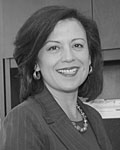 |
Human Resources Director Lori Barreras counts effecting an HR culture change and building credibility as the biggest challenges in her job. |
In a recent ORNL Reporter, an item quoted ORNL’s new director of Human Resources: “…be confident in making decisions. You’ll be right 85 percent of the time, 15 percent of the time you’ll be wrong but you can fix it, and the other five you’ll just have to ask
forgiveness.”
Several readers spotted the Reporter’s typo: The math added up to only 105 percent. We’ll correct the record here: The new HR director’s level of effort has rarely dropped below 110 percent since she took the position last August.
ORNL’s Human Resources organization has undergone a significant retooling, orienting itself much as the Laboratory has toward attracting and keeping world-class staff members for a world-class facility.
Lori, an Arizona native who came to ORNL from Pacific Northwest National Laboratory, recently shared her views on her goals and the Lab’s HR challenges.
HR has brought in a lot of new people. Are there major changes in HR’s mission or focus, as well?
HR’s overall goal is to provide expert, professional HR services to our customers throughout the Lab. By building a strong infrastructure, we will enable the Laboratory to attract, develop and retain an engaged and exceptional work force. We assessed the Laboratory needs and set out a number of goals. However, we realized that in order to meet our aggressive HR goals, we needed additional resources.
Over the past few years, we have realigned our organization and added additional key positions. We are now better staffed to deliver HR expertise in all areas: labor relations, compensation, organizational development, benefits, recruiting, equal employment opportunity/ affirmative action, international services and human resource generalists.
What HR-related things are coming up that will affect ORNL staff the most (in terms of, for example, changes in PADS or new development opportunities)?
Realizing that the changes will take a multi-year effort, we identified a number of new programs, tools, systems and services that will be systematically introduced to the Lab in the near future.
Some examples?
Trending data showed that the Lab’s previous performance rating system allowing seven potential ratings was not effectively being utilized as intended. Rather, only four of the seven ratings were used with frequency, so we will begin using the new four-rating system in FY 2006.
In the area of organizational development, we are in the process of identifying and designing a program to develop our future leaders. By providing tools and learning programs, we will increase overall effectiveness and groom high-potential staff.
The Employee Engagement Survey (see back page) will be sent to every staff member later this spring to assess the levels of staff engagement. The results of this survey will be delivered to each manager who has at least five responders to the survey. It will assist in starting a continuous dialogue between managers and the staff members to identify areas that are working well and areas that need additional attention for better productivity and employee satisfaction.
The way in which we recruit for talent is going to undergo a significant improvement. Expert recruiters will assist managers in sourcing top talent and finalizing offers. We will improve the Lab’s ability to plan, predict and respond to our changing business environments with the right staff at the right time. Increased breadth in the applicant pools is expected and, as a result, we will ensure that we are hiring the best and brightest individuals. Robust pipelines will be available to ensure future availability of needed talent in time to meet business needs.
Comprehensive work force and succession planning must be implemented to ensure we understand our capability gaps and to ensure leadership continuity in key positions through planned development and placement of key staff over time.
Effective and efficient HR management systems will identify, define, monitor and manage risks to assure Lab compliance, system integrity and asset protection. We will conduct self-audits, expand compliance education and ensure the protection of confidential and private data.
What do you see as ORNL’s biggest HR-related challenge?
Probably the necessary culture change in the role HR played historically and the need to demonstrate value-added HR services to gain and maintain credibility. It is overcoming a legacy and understanding that the change will come gradually as we also settle into our new roles.
What does Jeff Wadsworth want from his HR organization?
Jeff has consistently emphasized the need for HR to become integral business partners with the directorates and provide professional HR guidance and counsel to all staff. He agrees that we need to build a strong infrastructure to support managers in more effectively managing staff. We have discussed a need to stress management accountability throughout the various levels of management.
New faces in HR
Human Resources has brought in new employees to help realize the directorate’s challenging goals. Following are some of the new faces.
Deborah Stairs rejoined ORNL last November to manage Organizational Development and Training. She returned to the Lab from Blue Rhino in Winston-Salem, N.C., where she was director of organization effectiveness. She has also worked for Eastman Chemical Company, Mirant Corporation and Anheuser-Busch.
Glenn Jennings is HR’s Equal Employment Opportunity-Affirmative Action specialist. He came to the Lab from Home Depot, where he worked in EEO/AA out of Long Island, N.Y. Glenn has DOE experience; he was previously Brookhaven Lab’s diversity manager. At ORNL, Glenn will focus on increasing diversity metrics, including working closely with minority and women-oriented career fairs and Historically Black Colleges and Universities.
As labor relations manager, Les Morgan is based in Building 2518. He came to ORNL from a similar position at Arkema Chemical, a coal, steel and chemical firm. He has 20 years’ experience in labor relations.
Patricia Neal serves as senior recruiter for the Biological & Environmental Sciences and Physical Sciences directorates. She comes to ORNL from the Seattle, Wash., area and previously worked for MicroSoft and Oracle.
Kathy Finnie is senior HR manager for the Energy and Engineering Sciences Directorate. She came to the Lab from Tecnoglas, formerly Owens-Illinois, in Columbus, Ohio.
Kari Durham came to the Lab in December from North Carolina, where she worked for Solectron Corporation and St. Andrews College in Laurinburg. She is senior HR manager for the Biological & Environmental Sciences Directorate.
Boston native Mike Palermo is senior HR manager for the Computing & Computational Sciences Directorate. Mike’s varied career has included finance and accounting. He came to the Lab for the Portland, Ore., area, where he worked for CH2M Hill.
University recruiter Emily Bartlett previously worked for Honeywell, where she managed the university relations function. She is a graduate of Baylor and Ohio State universities.
These new folks join HR managers Judy Trimble with the Spallation Neutron Source, Kevin Trent with the Physical Sciences Directorate and the High Flux Isotope Reactor, Dave Rupert with the Facilities & Operations and National Security Directorates, Craig Parker with the Environment, Safety, Health & Quality Directorate and Janet Swift with the support directorates.
Mike Willard is an HR mainstay at the Lab, serving over the years in a number of roles. He now watches over the Lab’s compensation program and HR’s information technologies, which include the equally familiar Performance and Development System, or PADS.
Mark Wagner, stationed at the Commerce Park office complex near Oak Ridge, manages the Lab’s Benefits program.—B.C.
 Wadsworth: New Lab facilities attracting interest
Wadsworth: New Lab facilities attracting interest
The growing globalization of R&D, which ORNL Director Jeff Wadsworth has seen at first hand in his recent trips abroad, was one of the subjects of this year’s first Senior Managers Meeting on March 23.
As Energy Secretary Bodman indicated in his 2005 visit, other nations are expanding their science programs. On last fall’s trip to China, Jeff visited a new nanoscience facility in Beijing, financed by a Taiwanese billionaire. Foreign researchers who have come to the United States are being lured back home by such facilities, he said. Similar initiatives in India, South Korea and other developing nations point to a much more competitive global science scenario.
Competition is particularly heated in computing, where, as Jeff noted, 1998’s high mark of 1.8 teraflop/s now barely cracks the Top 500. However, to house these increasingly powerful machines, “you need a facility most people don’t have,” he said. ORNL’s Computational Sciences Building, with its electrical power supply and cooling capacity, represents that sort of facility. Similarly, while the Spallation Neutron Source will lead neutron science, other countries, particularly South Korea, are planning lesser neutron sources.
Lawmakers and policymakers are responding with legislative initiatives such as the President’s American Competitiveness Initiative, which addresses the recommendations of a recent report from the National Academies, “Rising Above the Gathering Storm.” This report, requested by senators Lamar Alexander and Jeff Bingaman, is a wake-up call that includes contributions by several Lab staff members.
Jeff noted that Sen. Alexander and Gov. Phil Bredesen both have asked him questions about ORNL’s stances on energy policy and education during recent visits, and he thanked Lab staff for their response to these challenges.
Bright spots of Jeff’s presentation included the Lab’s nuclear nonproliferation programs, where ORNL is now a “preferred provider” among labs, with a very significant share of the budget. The Multipurpose Research Facility, nearing completion on the east campus, will further spur growth in that area.
He reported that there is interest from industry in building a research center on the mostly empty northwest portion of the Lab’s central campus. Other institutions are eyeing the Lab’s new facilities, with their new and robust infrastructures, as grounds for future partnerships.—B.C. ![]()
 SNS’s Holtkamp tabbed for ITER management team
SNS’s Holtkamp tabbed for ITER management team
Norbert Holtkamp, director of the Accel- erator Systems Division at the Spallation Neutron Source, has been nominated to be principal deputy director-general of ITER, the international fusion reactor project.
Norbert has led the development of the accelerator portion of the SNS. With the successful commissioning of the accumulator ring earlier this year, the front-end, warm and cold linac and ring components of the SNS are essentially complete. The complicated job has gone more smoothly than expected.
|
|
Gov. Phil Bredesen (right) spoke at the opening of Particle Accelerator Conference 2005, held in Knoxville last May and chaired by Norbert Holtkamp (left). |
“Working at SNS has been the experience of my lifetime. Being deeply involved in the management of a multi-lab collaboration was exactly the qualification I needed to be able to apply for ITER, where the SNS way of building a large science project is now applied on an international scale,” Norbert says.
A native of Germany, Norbert came to ORNL from Fermilab. Last May his standing in the physics community rose as he chaired the Particle Accelerator Conference 2005 in Knoxville, Tenn., attended by 1,500 researchers from around the world.
Fusion Energy Division Director Stan Milora agrees that ITER sought Norbert because of similarities in the ITER and SNS construction task.
“Much of the challenge with ITER, by nature of its being a fusion experiment in general and its ambitiousness in particular, will be in integrating complex systems and components that are highly interactive and interdependent. Integration is a very big part of ITER, and Norbert’s efforts in integrating the six-lab effort of the SNS has been remarkably successful,” Stan says.
Norbert will join Ambassador Kaname Ikeda, who was named as the ITER project’s director-general nominee in November 2005.
The ITER project is an international fusion effort involving the European Union, India, Japan, South Korea, China, Russia and the United States. The project will be built in Cadarache, France. The U.S. ITER program office was relocated to ORNL earlier this year. The Lab’s experience of large project procurement was a leading reason for the move.
“This is a tremendous honor for ORNL and for Norbert, who has established a sterling record as director of the Accelerator Systems Division,” Lab Director Jeff Wadsworth said in his message to Lab staff members, who noted that the program office would likely often bring Norbert back to Oak Ridge.
ITER is a major step toward an abundant, environmentally benign and economical energy source. A fusion power plant would produce no greenhouse gas emissions, use abundant and widely distributed sources of fuel, shut down easily, require no fissionable materials, operate in a continuous mode to meet demand and produce manageable radioactive waste.
“I will miss everybody on the SNS project. I have never had the honor of working with such a dedicated group of people and the success speaks for itself. I’m glad that the U.S. ITER project office is in Oak Ridge, which will bring me back from time to time to visit colleagues that became friends,” Norbert says.—B.C. ![]()
 |
 ORNL, NIST team on PET tech
ORNL, NIST team on PET tech
ORNL’s Metrology Lab, featured in the March Reporter, dedicated its new partner lab with the National Institutes of Standards and Technology on March 30. NIST’s satellite facility in Building 5510A will promote measurement accuracy for nuclear medicine imaging.
NIST scientists will use the Nuclear Medicine Calibration Laboratory to prepare and measure radioactivity standards used for Positron Emission Tomography, the non-invasive imaging technique that helps doctors diagnose and treat diseases. An estimated 650,000 PET procedures were performed in 2003; the number is expected to reach as many as
two million annually by 2010.
The procedure involves the injection of a low-dose radiopharmaceutical that is metabolized in the part of the body being imaged. PET scanners create an image of the location and intensity of the radiopharmaceutical in the body. A PET image can be used to differentiate between healthy and cancerous tissue. For instance, a tumor uses more glucose than normal tissue and therefore appears brighter in an image.
NIST Director William Jeffrey and ORNL Director Jeff Wadsworth dedicated the facility, which will serve as a pilot for a series of facilities across the nation.
 Science writer’s G.U.T. feeling
Science writer’s G.U.T. feeling
Time magazine’s senior science writer, Michael Lemonick, was this year’s speaker at the annual Alfred and Julia Hill Lecture at the University of Tennessee. Owing to his line of work, people often contact Lemonick with their ideas. His topic, “Crank or genius: How does a science writer tell the difference?” exposed a dilemma for a science writer for a leading publication; i.e., is the person on the other end of the line a crank or the next Einstein?
Usually, it’s the former. Lemonick listed some tell-tale signs.
- They often have a Grand Unified Theory (G.U.T.) of something.
- They refer to Einstein.
- Their theory disproves the Theory of Relativity.
- They have created “free energy.”
- The subject is an “independent thinker”; that is, has no affiliation.
- The theory is not backed up by mathematics.
- There has been no attempt to publish the work.
